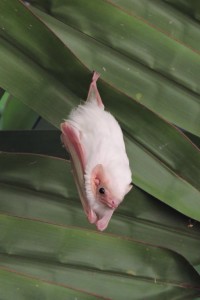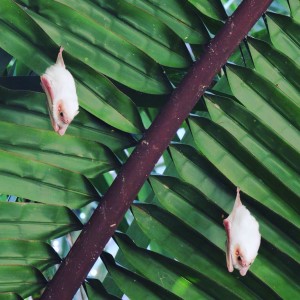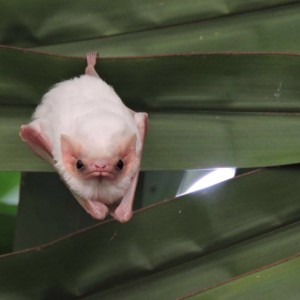We are so exited about finding in Refugio Nacional de Vida Silvestre Romelia some members of this species.
Diclidurus albus is rare but widespread, ranging from Mexico to eastern Brazil. Found in some Caribbean Islands including Trinidad. During the summer months, no sightings of D. albus have been made in Mexico, the northern edge of its range, suggesting that members of this species migrate south seasonally, from May to October. Little information is available on D. albus migration patterns.
Northern ghost bats prefer humid habitats like riparian and tropical rainforests also have been found in human-disturbed areas like plantations, clearings, and to villages. They prefer to roost underneath the fronds of palms, including coconut, chocho palms, and coquito palms. These bats are seen in less mesic habitats, like deciduous and evergreen forests. Diclidurus albus migrates within the Neotropics. They occur from sea level to 1500 m. Observed at highest elevations in Costa Rica
Physical Description
Diclidurus albus is a distinctive looking bat species. The common name, Northern ghost bats, refers to their soft, long, white pelage. Sometimes the proximal ends of the hairs are grey in color, while the distal ends are white, giving the animal an ashy grey tone.
Northern ghost bats have nearly naked faces with large eyes and shorter, yellowish ears. They do not have a nose leaf, and their tragus is prominent, broad, and rounded.
Northern ghost bats are solitary. They do not form colonies and found in small groups only during the breeding season. Northern ghost bats are nocturnal and roost under palms during the day. They tend to fly high and in reasonably straight lines. Most studies of D. albus have focused on physical properties instead of behavioral characteristics, so the behavior of this species is not well known.
Like all members of the family Emballonuridae, Northern ghost bats are insectivorous. Stomach contents have a high proportion of moths.
Economic Importance for Humans: Positive
Northern ghost bats may be significant in helping keep agricultural pest populations in check, but their rarity suggests that they might not contribute much to insect control.
Text by biologist Jennifer Rivera
Photos by Andrea Kasper
All rights reserved to Refugio Romelia


